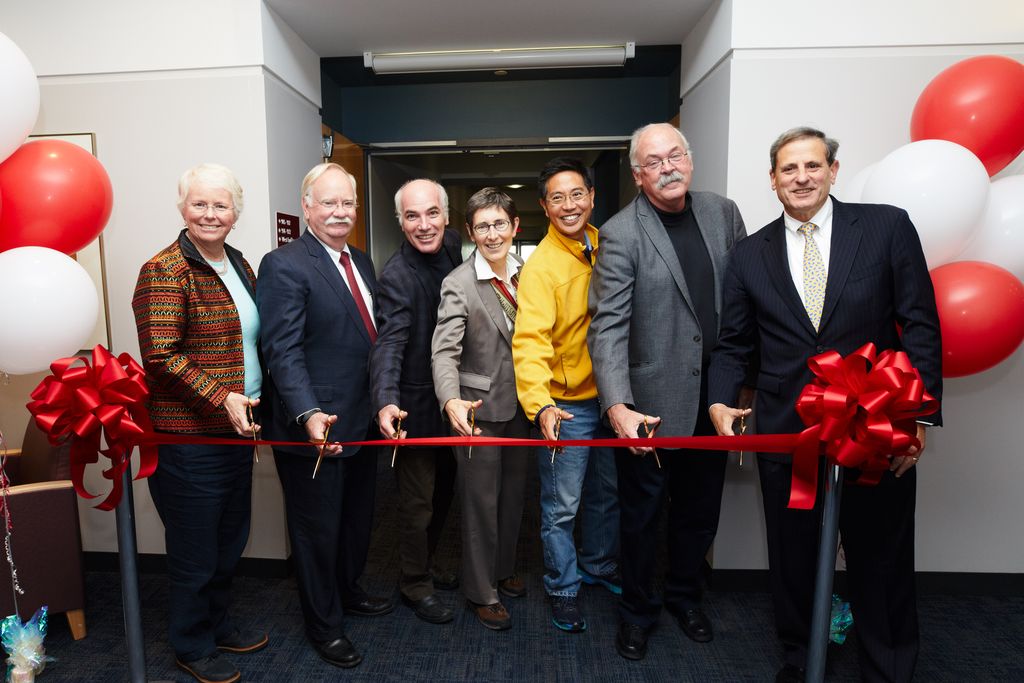Celebrating an ENG Research Milestone

Ribbon cutting opens the first BU-led ERC
by Liz Sheeley
The sounds of chatter and laughter bounced about as professors, administrators and leaders from Boston University came together to celebrate the beginning of a research endeavor that could change the way doctors treat heart disease. The ribbon-cutting ceremony and reception for the new $20 million National Science Foundation Engineering Research Center (ERC) that was held on October 2 recognized the victory of not just those who worked on the grant, but of the entire University.
“Boston University is a young research institution and the College of Engineering is an adolescent,” said President Robert A. Brown, noting that the College awarded its first PhD only 25 years ago. Winning the first BU-led ERC is an indication, he added, that the University must pursue collaborative, interdisciplinary research in order to compete for such awards with older institutions that have more resources. The vision of Brown and other leaders to make BU into a highly collaborative and top-tier research institution reached a milestone with the opening of the ERC, which has the goal to develop personalized heart tissue for clinical use.
“Once you hear that it’s possible, you have to do it,” said Professor David Bishop (ECE, Physics), head of the Division of Materials Science & Engineering and director of the ERC. He recalled when Professor Christopher Chen (BME, MSE) connected different areas of expertise within the College to formulate the Center’s one goal. Since then, it has been a two-year effort to go from a pool of 200 applicants to one of four recipients of the prestigious grant.
Chen will serve as the center’s deputy director and lead its cellular engineering efforts. Mechanical Engineering Chair Professor Alice White (ME, MSE) will lead nanomechanics research, and Photonics Center Director Professor Thomas Bifano (ME, MSE) will lead imaging research. The ERC also includes partner institutions Florida International University and the University of Michigan, and six affiliate institutions, including Harvard Medical School and Columbia University.
During the ceremony, Dean Kenneth R. Lutchen remarked that it wasn’t just the idea to create functionalized heart tissue that was the center of the grant, but “it was the idea that we could use these breakthrough technologies to do this at a scale in a low-cost and easy-to-manufacture way that could have a massive impact on cardiovascular medicine and transform clinical care.”
The five-year grant, renewable for a total of 10 years and $40 million, has a built-in goal to develop techniques and methods that can be translated for use in other organs to spread the impact of this research beyond cardiovascular medicine.
Winning a grant that will not just have a widespread impact within its lifetime, but also affect research for decades to come, was not something that was realized overnight. Lutchen remembered back a decade ago when plans were made to go after larger grants like this one. The College first had to build up its faculty and research reputation to be competitive with institutions that have more financial resources. Instead of reaching into the University’s pockets, the plan was to create ways for the faculty to reach out to each other to establish collaborations and connections and realize a goal that was larger than the sum of its parts.
Bishop began his remarks by saying that he felt as though he had won the Super Bowl, and that, like playing football, this was a team effort. He thanked all the faculty and staff who spent thousands of hours working on the proposal. To Bishop, the long process to win the ERC felt like climbing a mountain and they were finally at the top. But he sees an even larger mountain in front of them — developing a cure for heart attacks.
“We should enjoy being on top of the mountain for a little while,” said Bishop. “But then tighten up our shoes, put on our packs and head out because we have a tough, hard, 10-year task in front of us.”